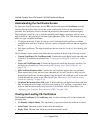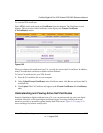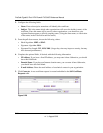
ProSafe Gigabit 8 Port VPN Firewall FVS318G Reference Manual
5-32 Virtual Private Networking
v1.1, August 2010
Understanding the Certificates Screen
To display the Certificates screen, select VPN form the main menu and Certificates from the
submenu. Because of the large size of this screen, and because of the way the information is
presented, the Certificates screen is divided and presented in this manual in different figures.
The Certificates screen lets you to view the currently loaded digital certificates, upload a new
digital certificate, and generate a Certificate Signing Request (CSR). The VPN firewall typically
holds two types of digital certificates:
• CA digital certificates. Each CA issues its own CA identity digital certificate to validate
communication with the CA and to verify the validity of digital certificates that are signed by
the CA.
• Self digital certificates. The digital certificates that are issued to you by a CA to identify your
device.
The Certificates screen contains four tables that are explained in detail in the following sections:
• Trusted Certificates (CA Certificate) table. Contains the trusted digital certificates that were
issued by CAs and that you uploaded (see “Viewing and Loading CA Certificates” on this
page).
• Active Self Certificates table. Contains the digital self certificates that were issued by CAs
and that you uploaded (see “Understanding and Viewing Active Self Certificates” on
page 5-33).
• Self Certificate Requests table. Contains the self certificate requests that you generated.
These request may or may not have been submitted to CAs, and CAs may or may not have
issued digital certificates for these requests. Only the digital self certificates in the Active Self
Certificates table are active on the VPN firewall (see “Obtaining a Self Certificate from a
Certificate Authority” on page 5-35).
• Certificate Revocation Lists (CRL) table. Contains the lists with digital certificates that have
been revoked and are no longer valid, that were issued by CAs, and that you uploaded. Note,
however, that the table displays only the active CAs and their critical release dates. (see
“Managing your Certificate Revocation List (CRL)” on page 5-38).
Viewing and Loading CA Certificates
The Trusted Certificates (CA Certificates) table lists the certificates of CAs and contains the
following data:
• CA Identity (Subject Name). The organization or person to whom the certificate is issued.
• Issuer Name. The name of the CA that issued the certificate.
• Expiry Time. The date after which the certificate becomes invalid.


















